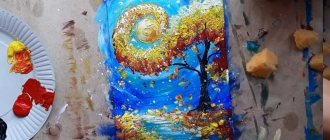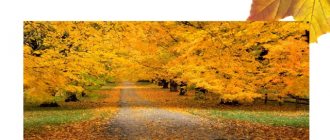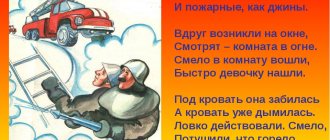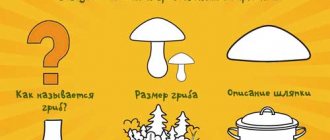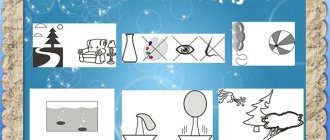Lesson summary “Golden Autumn”
Theme of the week “Golden Autumn” Familiarization with the world around us 1. Children should know: *names of the autumn months, the main signs of autumn;
*changes that occur in autumn in the flora and fauna; *what people do in the fall, how they dress; *distinctive features of early and late autumn. 2. Children should be able to: *generalize, compare signs, specify concepts, highlight the main signs of autumn, analyze phenomena, use existing knowledge about autumn in solving problems, performing exercises, assignments; *be interested in the phenomena of living and inanimate nature; *be able to establish cause-and-effect relationships (changes in living and inanimate nature and changes in external conditions: the gradual extinction of plant life is caused by cold weather; the departure of birds is associated with the disappearance of insects and the freezing of water bodies). 3. Game “Before-between-for”. Consolidating ideas about the seasons, an exercise in time orientation. (What time of year will come before autumn, after autumn, between summer and winter (autumn), between winter and summer (spring), etc.) 4. Game “Echo”. Practice the formation of complex words using the method of adding stems. Leaves are falling. - This is leaf fall. The stars are falling. - This is a meteor shower. The water is falling. - This is a waterfall. Stones are falling. - It's a rockfall. It's snowing. - It's snowing. 5. Game “I’ll start, and you finish” People in the fall are dressed (in what?) -...; schoolchildren go with their briefcases (where?) - ...; the leaves on the trees have become (what?) - ...; flowers in the flower beds (what did they do?) - ...; birds fly away (where?) - ...; animals do for the winter (what?) - ...; people collect in forests, gardens, fields and vegetable gardens (what?) - ... . 6. Compose a descriptive story on the topic “What clothes do we wear in the fall” according to plan: a) Why do we dress warmer in the fall than in the summer? b) What do we wear on our feet (in dry weather and in rain)? c) What do we put on the body? d) What do we wear on our heads, necks, hands? d) When do we take an umbrella with us? Speech development 1. Dictionary. Nouns: autumn, cloud, rain, weather, leaf fall, dirt, earth, dampness, jacket, raincoat, boots, hat, gloves, sweater, umbrella, September, October, November. Verbs: pour, blow, step on, wither, drizzle. To wilt, frown, sprinkle. Adjectives: Cold, wet, gloomy, autumnal, oblique, dull, cloudy. Golden (autumn), gray (days), chilly, pouring, drizzling. Adverbs: Wet, damp, stormy, cloudy. 2. Game “Say otherwise.” An exercise in selecting synonyms. A dull time - dull, sad, dreary, gloomy, sad. The sky is gray - dark, cold, cloudy. Trees are naked - naked, naked (without leaves). The flowers dried up and withered. 3. Game “Say the opposite”. Search for antonyms. Early autumn - late autumn. A happy day is a sad day. Sunny day - cloudy day. White cloud - black cloud. 4.Form high-quality adjectives. Autumn - autumn; November – November; sun - sunny; September – September; rain - rainy; cold - cold; October - … ; cloud - … ; warm - … . 5. Select actions (what does it do?). Rain - dripping, pouring, drizzling, coming... . The wind blows, blows, blows, breaks.... 6. Game “One - many”. Formation of the plural of verbs, nouns and adjectives (say according to the example). An autumn day has come - autumn days have come; there is a yellow leaf on the tree - there are yellow leaves on the trees; a dark cloud is floating - dark clouds are floating; there is a big tree - there are big trees; it's cold raining - it's raining coldly; a strong wind blows - heavy rains blow; a warm jacket is hanging - warm jackets are hanging; a flock of birds is flying - flocks of birds are flying. Learning to read and write Topic “Vowel sound O, letter O” 1. Determine by ear the place of the sound in words: wasps, catfish, popsicle, mustache (there is no O sound). 2.Remember the difference between a sound and a letter. We pronounce sounds and write letters. 3.Analysis of the letter O. What object does this letter resemble? There is no angle in this letter, that is why it is round. Look at the wheel - And you will see the letter O. 4. Write this letter in the air. 5. Riddle It grows on the bushes in the garden, The smell is sweet, like honey, But often the tears flow Those who tear with their hands... (Roses) You can tell the child a little about the rose. (The rose is called the queen of flowers. It is the most fragrant and the most beautiful.) *How can you say about a rose? The child himself gives definitions and synonyms. For example: beautiful, wonderful, charming, magnificent, etc. Then comes the analysis of this word, division into syllables (orally). Let's draw a diagram: 6. Phonetic game “Who is more attentive?” Didactic task. Develop phonemic awareness; to develop the ability to hear the sound O in words. The child, after listening to the tongue twister: That’s why Sovronya was given a snout, so that she could dig the earth, counts and names words with the sound O. Remember and name as many words as possible. Option. The child can be offered words with the sound O in different positions - not only at the beginning of the word. (For example: windows, boots, cinema, etc.) 7. Game “Catch the sound “O”” (clap your hands) *Isolating sound: -from the sound series: o, a, u, i, o, i, a, o, a, y, o, i, e, etc.; -from the syllabic series: at, from, op, un, ik, ok, etc.; -from a number of words: fence, cabbage, vegetable, tail, old man, cat, rooster, glass, toad, beetle, taxi, cake, etc. FEMP 1. Reinforce the composition of the number 6, graphically depict the number 6. 2. Develop logical thinking and spatial imagination. 3.Practice in solving problems, identifying parts in a problem. 4. Game exercises: “Whoever knows, let him continue” (goal: practice counting within 10 in forward and reverse order), “Name the neighbors of the number.” 5. Consolidating the composition of the number 6 (3da3; 5da1; 4da2; 2da4; 1 and 1, da1, da1, da1; da1). 6.Working with a number segment. 7.Work on the sheet “Continue the pattern.” (For example, a circle, square, triangle, circle, square is drawn on a sheet of paper. The child must then continue the drawing itself to the end of the line)
“Hello, golden autumn!”
Lesson-tour of the world around us
in 2nd grade on the topic “Hello, golden autumn!”
Completed by: Lyudmila Mikhailovna Maslennikova, primary school teacher
Target:
consolidate students’ ideas about the characteristic signs of autumn and autumn changes in nature.
Objectives:
1. Educational: to consolidate the concept of “the world around us”; expand students’ understanding of the signs of autumn; form the concept of “living” and “non-living” nature. 2. Developmental: develop the ability to observe autumn changes in nature, memory, attention, coherent speech, emotional and aesthetic responsiveness to the beauty of native nature. 3. Educational: to cultivate a respectful attitude towards each other, towards the opinions of their comrades; to cultivate a caring attitude towards nature and love for one’s native land. Progress of the lesson Guys, we have an unusual lesson today. You and I will go on a journey. Where, guess the riddle. The house is open on all sides, It is covered with a carved roof, Come into this house, You will see miracles in it! (Forest, park)
-Yes, today we will go on a trip to our city park to visit the golden autumn. We will observe, collect leaves, twigs, and complete tasks. -What will we travel on? Children
: Let's go with our feet, on foot.
Why? Children
: To take a good look at everything, admire the beauty of our native nature, and observe.
During our journey we will make several stops and rest stops, just like tourists do. 1 stop "Polyanka".
When entering the park, we must leave behind a clean clearing, otherwise there will be trouble on our planet Earth.
Game "Finish the sentence"
Remember!
1.The fire becomes overgrown after……..8 years. 2.Paper rots after…..3-4 years. 3. A tin can will decompose in…..60-70 years. 4.A plastic bag will decompose in…..200 years. -Conclusions
(children make) -Teacher: Guys, look how beautiful the park is on autumn days. Against the golden background of yellowed foliage, spots of painted maples and aspens stand out; slowly circling in the air, yellowed leaves fall from the birches. Quiet in the park. The songbirds flew away to warmer lands. But from tree to tree there are thin silver threads of a thin web.
Autumn!.. Our whole poor garden is crumbling. Yellowed leaves are flying in the wind. Only in the distance they show off - there at the bottom of the valleys, Bright red brushes of withering rowan trees. A.K. Tolstoy -What can we call everything that surrounds us? (The world around us) -Name what you see in the park? (Children's answers) -What is created by nature? (Children's answers) - What is created by human hands? (Children's answers) -What kind of nature is there? (Living and nonliving) -Look at the tree. What bird is sitting on a tree? (Magpie, crow). -Is it “living” or “non-living” nature? Prove it. 2nd stop “Trees”
.
Didactic game.
“Which tree?” • Heart-shaped leaves of... (linden) • Red berries of... (rowan) • White-trunked..... (birch) • Needles of....
(pine trees) • Carved leaves from ..... (maple) Game “Magic leaf”.
Work in groups.
I have a magic leaf. He will fall into your hands and ask questions. Teacher. I will show you fallen leaves, and you name the tree. -Find the difference between a leaf and a needle. -How has the appearance of leaves, needles and grass changed with the arrival of autumn? — Which trees have preserved fruits? (On the rowan tree, on the viburnum) Children read poetry. Victoria Ivanova
Matinees began more often, Sprinkling handfuls of silver And the rowan tree in the dark thicket Saved the generosity of summer.
Red berry - late dawn, How bitter and how good you are! Kuznetsova Nadya
Ah, the magic berry! The bride in the month of May is curtained all with white, Flowers are like lace. And in the fall, beautiful, red viburnum grows, After all, this is how different the beauty is alive in it.
Teacher. Guys, listen to the legend about viburnum. There lived in a village a wonderful girl named Kalinka. People respected her for her kind heart. In the spring, Kalinka always went to the forest. A long road led to him. “Let me,” he thinks, “let me plant bushes and trees along the road.” She dug up a tiny stalk in the forest, planted it by the road, and in order for it to grow, Kalinka carried water all the way from her hut and watered it. The bush grew, blossomed, and then bright red berries appeared on it. Travelers go, relax in the shade and thank those hard-working hands that planted the bush. One day Kalinka came to her pet, tried the tart berries and was surprised. The seed inside the berry looks like a heart. And the bush whispers through the leaves: “This is in memory of your kind heart, and so that people don’t forget you, give me your name “Kalina.” Since then, people have called such bushes (or trees) viburnum.
3rd halt. "Weather in autumn."
Guys, what is the weather like in autumn? • Damp - damp • Cloudy - cloudy • Wind - windy • Clear - clear • Frost - frosty • Cold - cold • Raining - rainy -What signs of autumn do you know? Children. The sun is shining, but it does not warm; the day becomes shorter and the night longer; the grass withers, the leaves on the trees turn yellow and fall off; birds fly away to warmer climes.
4th stop “Migratory birds”.
Guys, name the birds.
— What are the names of birds that fly to warmer regions in the fall? (Migratory birds) - Birds that don't fly away? (Wintering birds) - Name the birds that winter in our area. (Sparrows, tits, woodpeckers, crows, magpies) Listen, take a closer look, what birds did you see and hear? (Children's answers) 5th halt.
“Sounds of Autumn” Sit on a stump, lean against a tree and listen to the sounds of autumn. What do you hear? Children. – The leaves are falling, as if autumn is crying. — The leaves are rustling. — The birds talk sadly. — The breeze barely rustles the leaves. — The sun gently warms your noses. Game "How".
Now listen to the sounds of nature so carefully that this sound can be repeated.
(Children depict how birds flap their wings during flight, the sound of a strong wind, how a leaf falls from a tree). Results of the excursion.
Relaxation. -What new did you learn today? — What did you like most? -What do you imagine nature to be like in 100 years? -What will be your contribution to preserving the nature of your native land?
